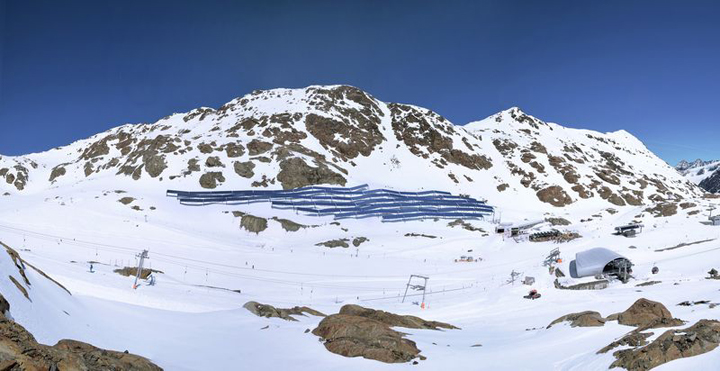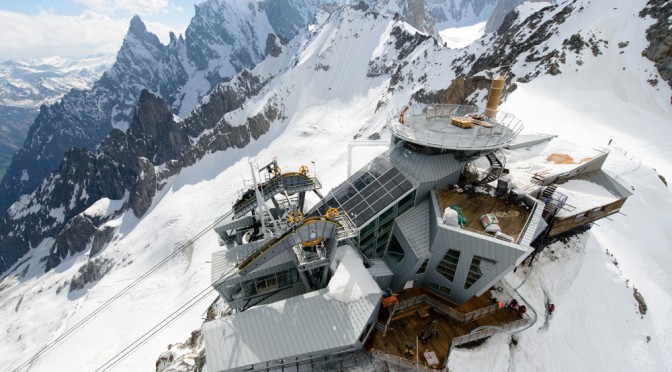Most ski resorts in the Alps put environmental issues at the forefront of their thinking these days, but some go further than others.
Pitztal Glacier, Austria
Sometimes ski resorts really think ‘out of the box’ when planning their long term energy needs and Austria’s highest ski area, the Pitztal Glacier, realised it could take advantage of its altitude to generate more green energy than lower ski centres when it decided to make a multi million euro investment in a new solar power system which came on stream last autumn, just as its long season began in September 2015.
Ski resorts are often located in exposed, windy areas so can be good for wind turbines, but the big move in the past few years has been solar power with many new buildings and new lifts fitted with solar panels. In the last two seasons the first lifts to be 100% solar powered have also been unveiled.
That’s because placing solar panels at higher altitude can make them twice as efficient although they can be the problem of snow settling on them. Pitztal’s new system generates approximately 1,450,000kWh of power annually, energy equivalent to the needs of 380 to 420 households per year and representing around a third of the ski centre’s energy requirements. The farm covers 100m² and has solar panels which can be tilted to maximise exposure to sunlight and when needed to tip off snowfall.

Courmayeur, Italy
When you’re going to spend nearly £100m and four years building the world’s most spectacular lift, it’s worthwhile thinking about making it as ‘green’ as you can for the sake of future generations.
That was the thinking behind Courmayeur’s amazing Monte Bianco lift on the Italian side of Mont Blanc (Monte Bianco in Italy) which rises in two stages with revolving cable cars providing spectacular views as it climbs.
Point Helbronner, the top station some 3466m up, built on a very small footprint in one of the most hostile environments on earth was none the less constructed to be an almost zero-energy building, thanks to extensive solar powers to generate energy and state-of-the-art insulation to keep the heat in, once generated on site.
Architect Carlo Cillara Rossi said his aim was to create a self-sufficient building that did not require external energy so much of the external surface of Point Helbronner has a photovoltaic surface to convert sunlight in to energy and there are also heat recovery systems to reuse energy within the building.
Tignes, France
It can be tougher for big ski resorts to ‘go green’ unless they are already in areas that use green hydro-electricity already. These are such big operations that it takes a while to turn all business thinking to put green thinking first, to be fair, since the turn of the century most big ski areas in the Alps have made that change to a greater or lesser degree.
And none more so that one of the biggest, Tignes. The resort which offers by far the most operational days for skiers and boarders in France thanks to its summer and autumn skiing on its glacier recently won Green Globe certification in recognition of the efforts of its lift company, the STGM (Société des téléphériques de la Grande Motte) to operate in a more environmentally friendly manner. It’s the only ski area in the world to hold this certification, which is re-assessed bi-annually (at which point further improvement is expected).
Green Globe is an international certification program to award efforts made by companies in the tourism industry for their social, economic, cultural, and environmental approach. Tignes had to meet a set of 40 criteria including more than 300 ‘compliance indicators’ covering everything from sustainable development to environmental protection.
Laax, Switzerland
Laax is well known for having some of the best terrain parks in the world, hosting events like the European Open and The BRITS freestyle competitions, but not so many people know that for more than five years the resort has had a programme in place called “Greenstyle” which aims to put environmental management at the heart of all operations and every new development decision the lift operating company makes.
This has many positive outcomes. There’s a hydroelectric power plant in Laax generating green power for the region and there are lots of other green energy initiatives including a snowmaking reservoir also used for hydro power generation and solar power facilities which even include a photovoltaic system that covers the power used to heat the seats in the resort’s 6-seater Alp Dado chairlift!
Other successfully implemented energy saving projects include LED lighting and heat recovery projects whilst Laax’s grooming machines also conform to the high Euro 5 standard and hybrid drives are now being used. A new diesel/electric machine has generated savings of up to 20% in CO2 emissions.
And that’s just the beginning, the resort keeps meticulous track of its energy consumption and seeks to decrease usage, year on year. In their last annual report overall the targeted energy-saving measures over the previous year showed achieved savings of around 3,680 MWh, around 25% better than the previous year.

San Martino, Italy
San Martino di Castrozza in Italy’s Trentino region is one of Europe’s classic ski resorts, set in a particularly splendid location in the Dolomites, a UNESCO World Heritage site.
Thanks to being one of the earliest locations for hydro-electric power, more than a century ago, San Martino has always seen its ski lifts powdered by green electricity. In fact it makes so much green electricity it produces 10 times more than it needs, exporting the excess to the grid. As it’s a locally owned public company the resulting revenue come back to the resort, and over the past 15 years the resort they have invested it in more eco-friendly measures to be able to claim to now be one of Italy and the world’s most eco-friendly ski resorts.
For one thing the region has put a huge investment in to a biomass heating system which now supplies 98% of the local population with green heating from a central point. The numbers of hydro and biomass combined are very impressive with 145MW of green energy are produced each year, enough for 150,000 families. That’s the equivalent of 88 thousand tonnes of petrol saved each year and as result 270 thousand tonnes less CO2 don’t end up being emitted in to the air that otherwise would be.
The municipality has their own fleet of electric vehicles and no less than 16 public charging points for electric vehicles where visitors can charge up their electric and hybrid cars for free.
Patrick Thorne, SaveOurSnow.com
